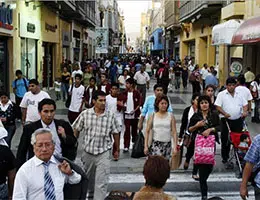 Society is made up of a group of people who interact with each other in the same space, have common interests and live together according to various shared norms and rules. In this group of individuals it is possible to recognize different classes : strata or categories that arise from common characteristics linked to economic means, ideologies, customs and other issues.
Society is made up of a group of people who interact with each other in the same space, have common interests and live together according to various shared norms and rules. In this group of individuals it is possible to recognize different classes : strata or categories that arise from common characteristics linked to economic means, ideologies, customs and other issues.
It is common for society to be divided into three large classes: the lower class , the middle class and the upper class . This stratification is given mainly by the availability of economic means : those who have the least are in the lower sector of society (the lower class), while those who have more resources occupy the upper sector (the upper class). In the center appears the middle class .
The people who make up the middle class, therefore, have a socioeconomic level higher than that of the individuals who make up the lower class, but lower than that of the subjects who make up the upper class. In many countries it is said that the middle class is the broadest social class , although this assertion is often questioned by sociologists and economists.
The emergence of the middle class occurred in the 18th century following industrialization , which allowed the development of new jobs and enabled the social advancement of some groups. As the gap between workers (the lower class) and capitalists (the upper class) expanded, various professionals and petty bourgeois (the middle class) remained among them.
In its origins, the people who would later become part of the middle class were found in the landed bourgeoisie (the lower nobility and rich commoners), who were beginning to stand out for their success in the commercial, professional and industrial fields.
The emergence of the landed bourgeoisie took place due to the liberal revolutions that occurred in England during the 17th century, which weakened the monarchy and caused the aristocratic class to lose power in favor of the bourgeoisie , which managed to enter Parliament. .
 Already in the 20th century, the modern middle class emerged in North America. The automotive industry, among others, began to use innovative production techniques, thanks to which it was possible to reduce prices and increase workers' salaries. In this way, a portion of the low-income population became richer and had access to better living conditions .
Already in the 20th century, the modern middle class emerged in North America. The automotive industry, among others, began to use innovative production techniques, thanks to which it was possible to reduce prices and increase workers' salaries. In this way, a portion of the low-income population became richer and had access to better living conditions .
Perhaps one of the most outstanding characteristics of the middle class is that the majority of its members do not feel bothered by belonging to it (as can happen with the lower class) nor are they afraid of descending (something that worries the upper class). Being middle class has many advantages over the other two, even though it is one step below upper class.
While lower class people cannot access a standard of living considered acceptable and healthy, the middle class has health services and the economic means to survive and indulge throughout the year . While they don't have the constant luxuries of the upper class, at least they don't have to worry about losing their status or maintaining their image of monetary power at any cost.
Precisely, one of the main features of the middle class is that it is not so defined, especially if we compare it with the remaining two. Poverty , the inability to protect oneself from inclement weather and hunger are terrible characteristics of the lower class; excess, expensive properties and exclusive clothing define the upper class in a nutshell; The middle class, on the other hand, is a much more varied world and, why not?, free.
